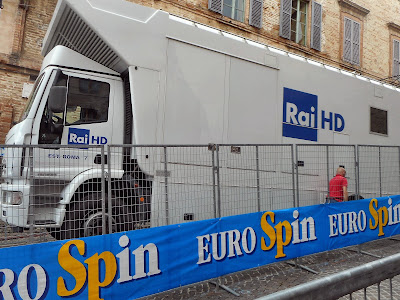We imagined things couldn't be much worse than what we had seen in Norcia (see "Terremoto" from May 14, 2018).
The hamlet of Spelonga disabused us of that assumption. Of the half-dozen buildings in town, not one was undamaged.
In the small village of Grisciano, things were even worse. The entire village had been leveled...save one building.
There was a small cafe housed in a prefabricated modular building, where a number of other people stopped...along with us...for a cup of coffee and a jaw-dropping peek at how a whole community just disappeared.
Across from the cafe was a large banner that said, "We will rebuild and return to the place of our hearts."
As we got closer to Amitrice, we saw a road sign for the town...and the road wasn't closed. So we took it.
Amitrice is nestled in a valley below the snow-capped peaks of the Appenine mountains. The natural setting is very pretty.
 |
| Courtesy: Wikipedia |
Remember this photo from our previous blog post?
This is what the main street of Amitrice looked like before the earthquake.
This is what that same main street looks like 22 months after the earthquake.
Before the disaster, the town of Amitrice was half-again as big as Pienza...still pretty small by current standards.
Most of the town is a "red zone," too dangerous to allow people in. The Italian military constantly patrols to keep rubberneckers (like us) from getting themselves into trouble.
Almost two years later, the amount of rubble that remains to be cleared away is staggering.
Only a geologist...or perhaps an architect...could understand why one house would collapse into a heap while the one next to it remained standing.
There are a handful of buildings scattered around that engineers believed can be saved...with proper reinforcement.
Meanwhile, the buildings will wait, wrapped in their scaffolding, until reconstruction of the town can begin.
Just beyond the far end of town... outside the red zone...the government has erected two small villages of prefabricated buildings.
This one is home to the six restaurants that existed in town before the earthquake.
A similar village houses the grocery, bank, and other businesses that used to line the main street.
It brings a few jobs to town. But with most homes destroyed and people living elsewhere, the community is on economic life support.
Amitrice is famous for one dish, served in all six of the restaurants... pasta all'Amitriciana.
We, of course, stopped for lunch and ordered their signature dish. Carol describes it a slightly spicy with white wine, olive oil, pepper, and pancetta.
As we were leaving town to return to Pienza, we saw a sign for where the restaurant and hotel used to be before the earthquake. We turned into the parking lot and saw...



























































